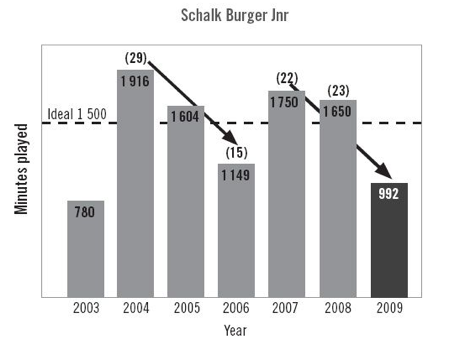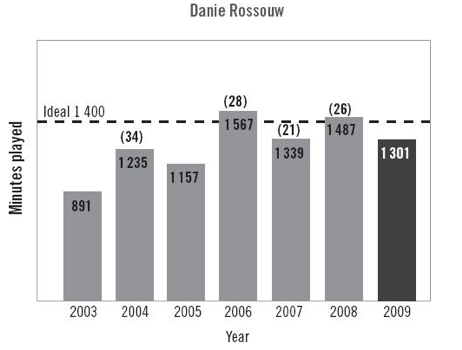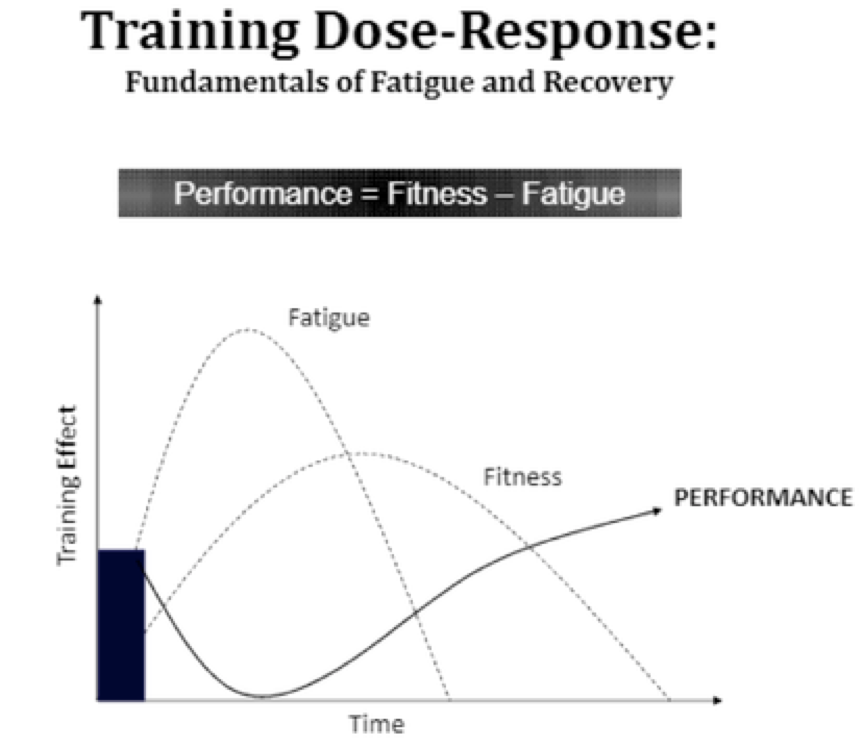How much work can athletes do before injury becomes inevitable?
I was asked this question this week by one of the South African Super Rugby franchises, who were concerned about how to manage their players into the end stages of the season. This is clearly a good question to ask because you don’t want to do all the hard work to reach the playoffs only to put in a weak performance because your best players are not available due to injury. So is there a certain threshold of playing or training beyond which a player’s injury risk becomes more significant?
This is certainly a popular point of view, with various media pundits regularly bemoaning the growing number of games per season. This is a particularly pertinent question in South Africa at the moment as the restructuring of both Super Rugby and Currie Cup has imposed a much greater playing load on our players this season. I did some fishing, and there is no definitive research in this area, but there are a few interesting viewpoints.
Tim Noakes in his book “Challenging Beliefs” dedicates a chapter to the concept that when players are over-exposed to match play in a particular season, they become more susceptible to injury the following year 1. He further substantiates this with actual player examples (Figure 1). In these examples, he shows that when Schalk Burger exceeded a “safe” playing threshold in consecutive seasons his playing time was reduced due to injury in the third season. In contrast, Danie Rossouw remained within the “safe”threshold and was able to play consistently throughout this period. Interestingly, Danie Rossouw retired at the end of 2014, and Schalk Burger is currently playing in his 14th season of professional rugby.

 Figure 1 – Professional rugby minutes played per season from 2003 to 2009 for two elite professional rugby players. Reproduced from Noakes, 2011.
Figure 1 – Professional rugby minutes played per season from 2003 to 2009 for two elite professional rugby players. Reproduced from Noakes, 2011.
This type of analysis certainly adds fuel to the fire of a high-risk threshold for playing time, but let’s have a quick look at what happens in other sports. In the recently completed 2015-16 NBA regular season teams were exposed to 82 matches each, with more than 100 players racking up more than 2200 minutes of court time (www.teamrankings.com). At the same time 49 Barclays Premier League soccer players spent more than 3000 minutes on the pitch this season (www.whoscored.com). Granted, the physical demands of these sports are very different from rugby, but these numbers do illustrate that the body can survive a lot of match exposure.
If we delve a little deeper into factors, other than total exposure to match play, that affect injury risk we see a slightly different picture emerge. Figure 2 shows the survival curves (time until injury) of professional rugby league players as differentiated by physical qualities (2). The first take-home message from these graphs for me is that the rate of injury is highest early in the season. The second important message is that well-developed physical qualities protect against injury. This means that if there is an exposure threshold above which playing the game becomes more risky (and I’m not sure that there is), that you could push out or extend that threshold by being better physically prepared.
 Figure 2 - Kaplan-Meier survival curves for completing matches free of contact injury for professional rugby league players. Two significant risk factors are shown: poor upper-body strength (chin-up), and poor prolonged high-intensity running ability. Reproduced from Gabbett et al., 2012.
Figure 2 - Kaplan-Meier survival curves for completing matches free of contact injury for professional rugby league players. Two significant risk factors are shown: poor upper-body strength (chin-up), and poor prolonged high-intensity running ability. Reproduced from Gabbett et al., 2012.
This leads me on to the concept of training stress balance, which was first proposed by Eric Bannister in 1975 (Figure 3) (3). For every training exposure (think rugby match now), there will be both a fatigue and a fitness response. Due to fatigue, in the hours or days following a rugby match the players physical abilities are limited, but as the effects of fatigue dissipate, performance capacity returns to similar or better levels than prior to the match.
 Figure 3 – Training dose-response relationship as summarized by Aaron Coutts (4)
Figure 3 – Training dose-response relationship as summarized by Aaron Coutts (4)
Based on this model, there should be no upper limit to the amount of game time that a player can safely participate in. Provided that the player is sufficiently physically prepared for the demands of the game, and that adequate time is available for fatigue to dissipate there’s no reason why a player couldn’t play 100 games.
Practically though there are a number of pitfalls that practitioners should be aware of. In rugby union particularly, there are a number of reasons why players might not be physically well prepared enough, or might have residual fatigue that would increase injury risk. One example is inadequate preseason training. If players don’t have the opportunity to develop the physical qualities necessary to cope with the demands of the game, fatigue will accumulate week on week and eventually injury will occur. I think that this is what was illustrated by the Tim Noakes example above. In South Africa, participation in the end of year springbok tour curtails preseason for these players leaving them at a disadvantage in terms of physical preparation.
Another difficult scenario for rugby S&C and medical staff to manage is the player who receives contact related “knocks” each week. These bumps and bruises generally resolve within a week, in time for the player to run out again and play his team’s next match, but often limit what can be done in training in the week preceding the match. In these situations, players can detrain because they don’t complete sufficient training in the week to prepare them for match demands. These players then become injury risks, not because they are fatigued, but because they are underprepared.
For practitioners, this means that on a weekly basis you typically have to juggle both fitness and fatigue stimulus to try and achieve an optimal performance every weekend. The question posed to us on a daily basis is “Are we working hard, or hardly working?” Both scenarios are risky, and the key to reducing injury risk lies in finding the balance between the two!
References
- Noakes T, and Vlismas M. Challenging beliefs: memoirs of a career. Zebra Press South Africa; 2011.
- Gabbett TJ, Ullah S, and Finch CF. Identifying risk factors for contact injury in professional rugby league players–application of a frailty model for recurrent injury. J Sci Med Sport. 2012;15(6):496-504. doi:10.1016/j.jsams.2012.03.017.
- Banister EW, Calvert TW, Savage MV, and Bach T. A systems model of training for athletic performance. Aust J Sports Med. 1975;7(3):57-61.
- Coutts AJ. Developing Athlete Monitoring Systems:. Athlete-tracking-and-technology-Using-microtechnology-in-sport-Aaron-Coutts.pdf. 2016.